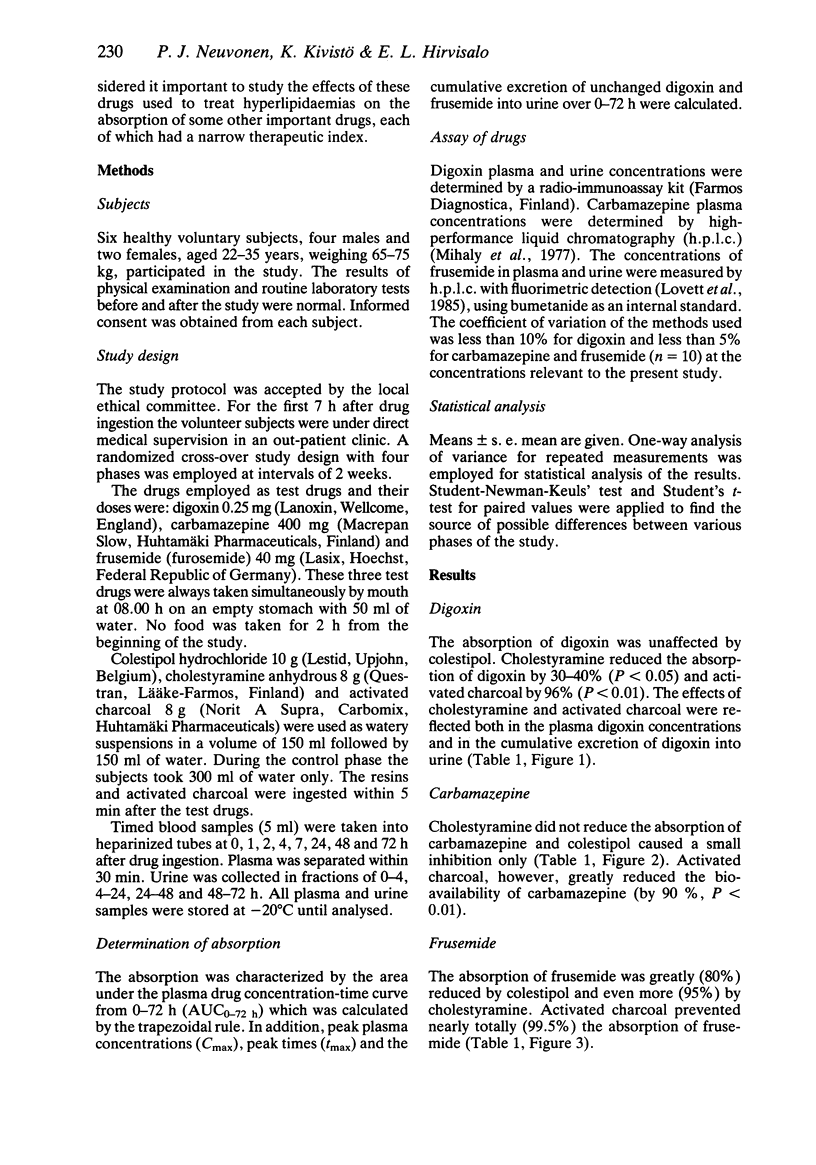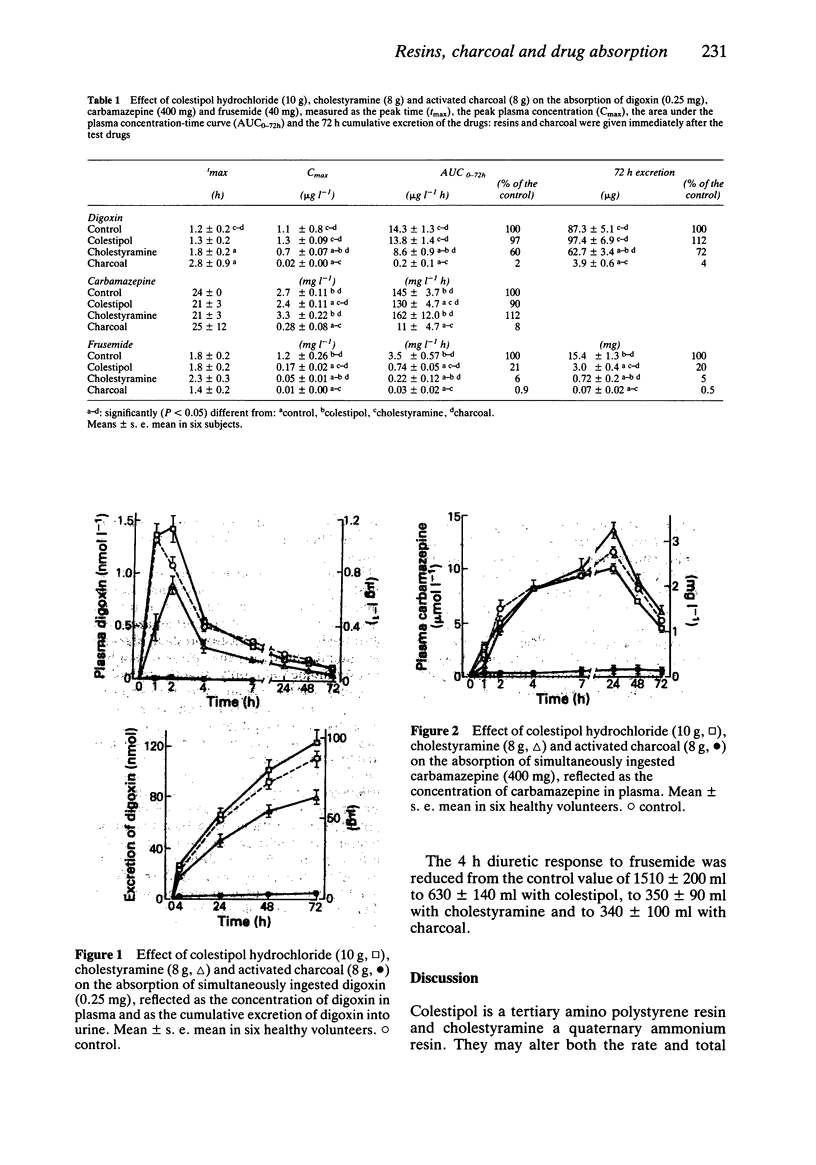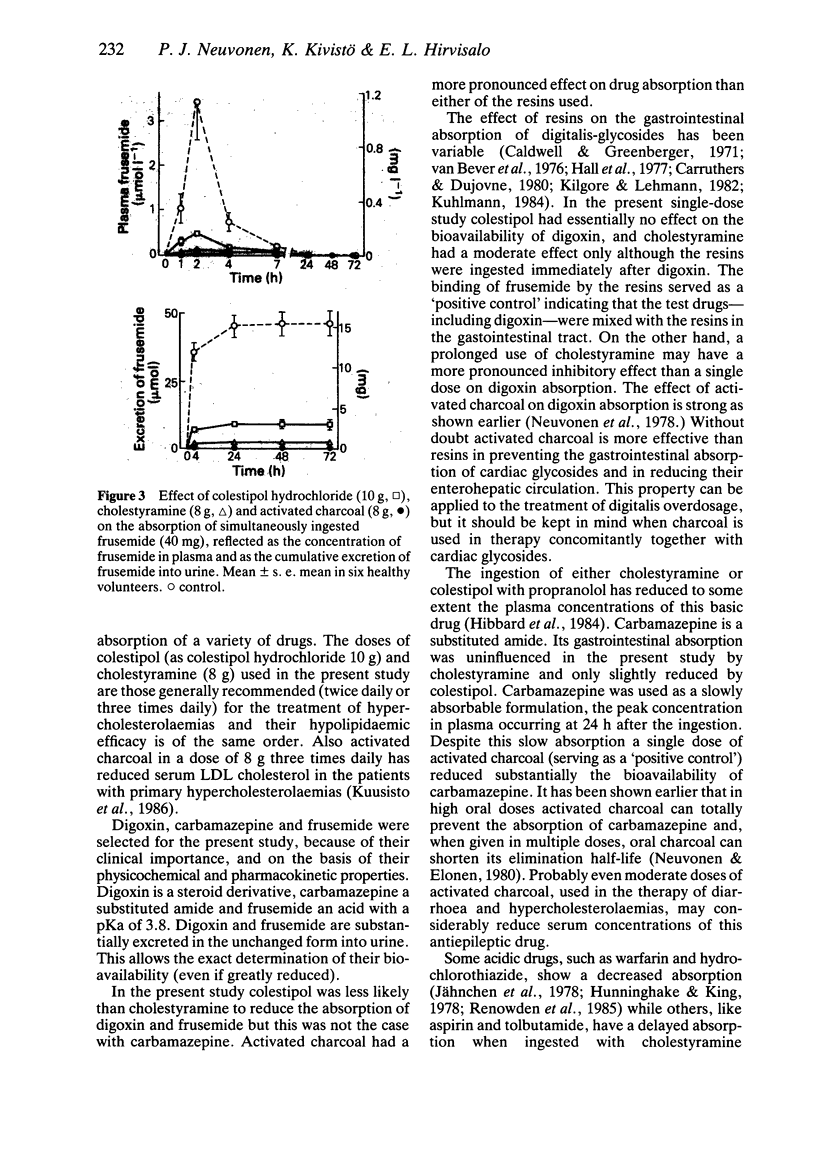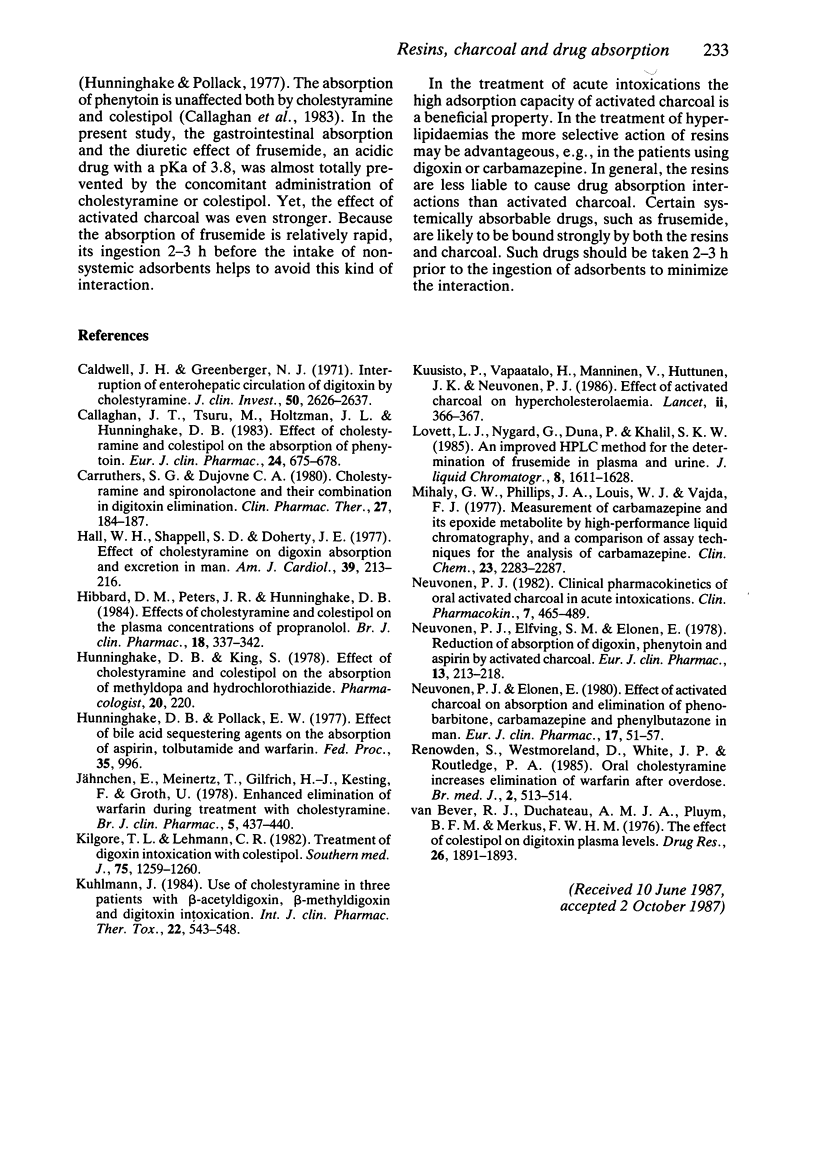Abstract
1. The interference of resins and activated charcoal with the absorption of digoxin, carbamazepine and frusemide was studied. 2. In a cross-over study consisting of four phases, single doses of colestipol hydrochloride (10 g), cholestyramine (8 g), activated charcoal (8 g) or water only were given to six healthy volunteers immediately after the simultaneous ingestion of digoxin (0.25 mg), carbamazepine (400 mg) and frusemide (40 mg). Plasma and urine concentrations of the test drugs and the urine volumes were determined up to 72 h. 3. The absorption of digoxin was not reduced by colestipol, moderately (30-40%, P less than 0.05) reduced by cholestyramine and greatly (96%) by charcoal. 4. The absorption of carbamazepine was not decreased by cholestyramine, slightly (10%) by colestipol and greatly (90%) by activated charcoal. 5. The absorption and the diuretic effect of frusemide were significantly diminished by all agents. The bioavailability was reduced by colestipol 80%, by cholestyramine 95% and by activated charcoal 99.5%. 6. The interference with the gastrointestinal absorption of most of the basic drugs by colestipol and cholestyramine seems to be minimal. On the other hand, the resins may seriously impair the absorption of certain acidic drugs, for example frusemide.
Full text
PDF




Selected References
These references are in PubMed. This may not be the complete list of references from this article.
- Caldwell J. H., Greenberger N. J. Interruption of the enterohepatic circulation of digitoxin by cholestyramine. I. Protection against lethal digitoxin intoxication. J Clin Invest. 1971 Dec;50(12):2626–2637. doi: 10.1172/JCI106763. [DOI] [PMC free article] [PubMed] [Google Scholar]
- Callaghan J. T., Tsuru M., Holtzman J. L., Hunninghake D. B. Effect of cholestyramine and colestipol on the absorption of phenytoin. Eur J Clin Pharmacol. 1983;24(5):675–678. doi: 10.1007/BF00542221. [DOI] [PubMed] [Google Scholar]
- Carruthers S. G., Dujovne C. A. Cholestyramine and spironolactone and their combination in digitoxin elimination. Clin Pharmacol Ther. 1980 Feb;27(2):184–187. doi: 10.1038/clpt.1980.28. [DOI] [PubMed] [Google Scholar]
- Hall W. H., Shappell S. D., Doherty J. E. Effect of cholestyramine on digoxin absorption and excretion in man. Am J Cardiol. 1977 Feb;39(2):213–216. doi: 10.1016/s0002-9149(77)80193-8. [DOI] [PubMed] [Google Scholar]
- Hibbard D. M., Peters J. R., Hunninghake D. B. Effects of cholestyramine and colestipol on the plasma concentrations of propranolol. Br J Clin Pharmacol. 1984 Sep;18(3):337–342. doi: 10.1111/j.1365-2125.1984.tb02473.x. [DOI] [PMC free article] [PubMed] [Google Scholar]
- Jähnchen E., Meinertz T., Gilfrich H. J., Kersting F., Groth U. Enhanced elimination of warfarin during treatment with cholestyramine. Br J Clin Pharmacol. 1978 May;5(5):437–440. doi: 10.1111/j.1365-2125.1978.tb01651.x. [DOI] [PMC free article] [PubMed] [Google Scholar]
- Kilgore T. L., Lehmann C. R. Treatment of Digoxin intoxication with colestipol. South Med J. 1982 Oct;75(10):1259–1260. doi: 10.1097/00007611-198210000-00026. [DOI] [PubMed] [Google Scholar]
- Kuhlmann J. Use of cholestyramine in three patients with beta-acetyldigoxin, beta-methyldigoxin and digitoxin intoxication. Int J Clin Pharmacol Ther Toxicol. 1984 Oct;22(10):543–548. [PubMed] [Google Scholar]
- Kuusisto P., Vapaatalo H., Manninen V., Huttunen J. K., Neuvonen P. J. Effect of activated charcoal on hypercholesterolaemia. Lancet. 1986 Aug 16;2(8503):366–367. doi: 10.1016/s0140-6736(86)90054-1. [DOI] [PubMed] [Google Scholar]
- Mihaly G. W., Phillips J. A., Louis W. J., Vajda F. J. Measurement of carbamazepine and its epoxide metabolite by high-performance liquid chromatography, and a comparison of assay techniques for the analysis of carbamazepine. Clin Chem. 1977 Dec;23(12):2283–2287. [PubMed] [Google Scholar]
- Neuvonen P. J. Clinical pharmacokinetics of oral activated charcoal in acute intoxications. Clin Pharmacokinet. 1982 Nov-Dec;7(6):465–489. doi: 10.2165/00003088-198207060-00001. [DOI] [PubMed] [Google Scholar]
- Neuvonen P. J., Elfving S. M., Elonen E. Reduction of absorption of digoxin, phenytoin and aspirin by activated charcoal in man. Eur J Clin Pharmacol. 1978 May 31;13(3):213–218. doi: 10.1007/BF00609985. [DOI] [PubMed] [Google Scholar]
- Neuvonen P. J., Elonen E. Effect of activated charcoal on absorption and elimination of phenobarbitone, carbamazepine and phenylbutazone in man. Eur J Clin Pharmacol. 1980 Jan;17(1):51–57. doi: 10.1007/BF00561677. [DOI] [PubMed] [Google Scholar]
- Renowden S., Westmoreland D., White J. P., Routledge P. A. Oral cholestyramine increases elimination of warfarin after overdose. Br Med J (Clin Res Ed) 1985 Aug 24;291(6494):513–514. doi: 10.1136/bmj.291.6494.513. [DOI] [PMC free article] [PubMed] [Google Scholar]
- van Bever R. J., Duchateau A. M., Pluym B. F., Merkus F. W. The effect of colestipol on digitoxin plasma levels. Arzneimittelforschung. 1976;26(10):1891–1893. [PubMed] [Google Scholar]


